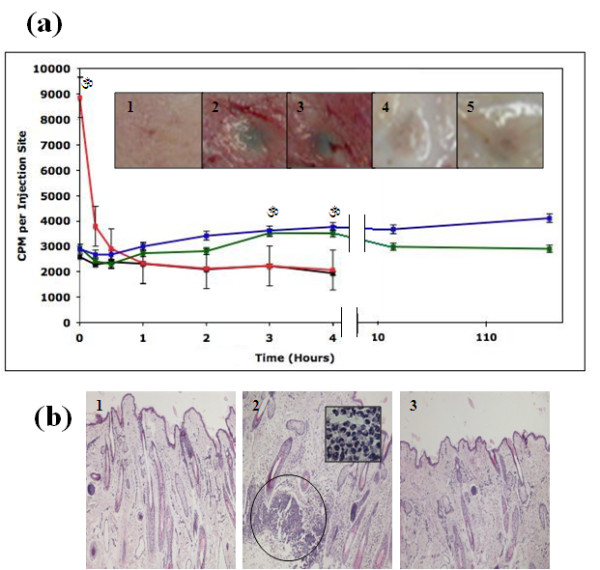Figure 4.

HAMC induces minimal inflammation in sheep. Introduction of HAMC (HAMC alone (green)) and HAMC infused with 3 μg/ml of ANG-2 and VEGF-C (blue) resulted in an increased accumulation of (a) 125iodine radiolabeled bovine serum albumin (125I-BSA) in comparison to saline (black) injections at corresponding time points. These vascular permeability increases reached significance at 3 and 4 hr postinjection; however, they appeared to resolve over a 1-wk period. Bradykinin, a transient vascular permeability inducer, was used as a positive control (red). Data are shown as means ± SEM (0-4 hr, n = 5; 24 and 168 hr, n = 2). Double lines indicate a change in scale. Significance in comparison to saline was assessed by ANOVA with accompanying one-way Dunnett's t-test. *P < 0.05. Similar results were obtained when Evans blue dye (EB) accumulation was examined ((a) inset), saline 4 hr (1), HAMC 4 hr (2) HAMC + GFs 4 hr (3), HAMC 1 wk (4), HAMC + GF 1 wk (5). (b) Hematoxylin and eosin-stained skin sections of injection areas were examined using a bright-field microscope at ×10 magnification. There were areas of heavy neutrophil infiltration in HAMC injection areas at 4 hr (2) in comparison to saline controls (1). Neutrophil infiltrations appeared to resolve over the next week in HAMC injection areas (3). Circle indicates an area of heavy neutrophil infiltration. Inset: Enlargement of cell infiltration area depicting classical morphology of neutrophilic cells, ×100 magnification.
